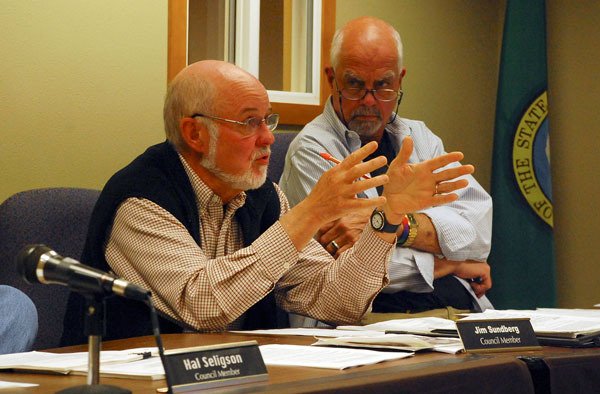Citizen complaints about a proposed water rate hike in Langley appear to have carried sway with city decision makers.
On Monday, the City Council rejected the preferred option of Mayor Larry Kwarsick and city staff, a plan created to be beneficial to the majority of users, for an alternate rate structure that would favor the pocketbooks of those who use the least amount of water.
While the council preliminarily approved the alternate schedule in a 4-1 vote, it was just a first reading. Before the new rates can go into effect, they have to be reviewed again and approved with a second vote.
In an interview Thursday, Kwarsick said his recommendation isn’t without shortcomings but was resolute about which option he thinks is best for the city and the majority of customers.
“Have I changed my mind?” Kwarsick said. “No. I still believe option 2 is the best for most people. And it’s best for utilities because it will provide the most predictable revenue stream.”
Langley has been in the process of updating its comprehensive water system plan, a document that outlines infrastructure projects over the next six years. The city’s current residential water rates are insufficient to cover the tab so three different rate-hike structures were developed for the council’s consideration.
Option 2, the city’s preferred alternative, seeks to establish a monthly base rate of $39.56 for up to 5,000 gallons of water. Additional usage would result in additional charges, the amount of which would depend on how much is used.
The city’s current residential rate structure carries a base rate of $25.46. However, that doesn’t cover a set amount of gallons. Instead, residents are charged 43 cents per 100 gallons.
While Kwarsick and Public Works officials have argued that most people will see a savings of $1 — that calculation is based on the average household usage of 117 gallons per day — more than a dozen people showed up to voice their concerns at a public hearing last month.
Many said the increase was too hefty and complained that the proposal was hardest on those who use the least amount of water. Their arguments did not fall on deaf ears.
City Councilman Jim Sundberg voiced strong support for option 3, which is geared toward those who use water sparingly. It suggests a monthly base rate of $30 for up to 3,750 gallons.
Sundberg credited city officials, particularly Public Works Director Challis Stringer, for their extensive work on the plans, but argued that the city’s recommendation “tilted the scales” of burden too heavily on those who are doing the best job conserving water.
The lower base rate would fill city coffers enough to pick up the project tab and provide more incentive for others to conserve as well.
“It’s a base rate I can much more easily defend,” Sundberg said.
He also pointed out that many of the capital projects the plans will pay for are to replace old water mains with larger pipes. With greater flow, he said the city’s problem of having to flush the pipes might actually be reduced.
Langley residents have done so well conserving water that it’s begun to cause problems. Sediment builds up in the pipes from low use, forcing the city to waste much of the water residents conserve by flushing the system. City officials hope option 2 will increase water use by about 1 million gallons.
Similarly, City Councilwoman Rene Neff said she has been approached by people who claim the proposed structure was such a financial leap that they could no longer afford to live in Langley.
“I’m concerned that when we raise the rates that steeply we’ll actually force some low income people out and I’d rather not do that,” Neff said.
Kwarsick responded by saying that the low users who would most benefit from option 3 represent a very small fraction of the city’s users — about 10 or 11 percent, he said.
“The cost for the other 90 percent of people is going to go up,” he said.
He also noted that a higher base rate provides more certainty for the utility as it will better guarantee a set amount of revenue as opposed to a structure where people have more control over what they pay based on water use.
Stringer also went to bat for option 2. Standing up and declaring that she was speaking just as a citizen, though she qualified that she doesn’t live in Langley, she said option 2 is more financially friendly for growing families who tend to use more water.
“I have teenage children who want to shower every day,” Stringer said.
“We want families here,” she said.
Sundberg disputed both Kwarsick’s claim that 90 percent of people would pay more and Stringer’s plea for families. He has a teenager in his house and they use about 3,000 gallons a month. While use will differ by family, he said you can’t definitively claim that option 3 drives out families.
“It’s an appealing argument but it’s not totally compelling,” he said.
In the end, the council voted to approve option 3 with City Councilman Hal Seligson being the sole opposition. He said he doesn’t view water as a commodity and wanted to get away from a cost-per-gallon system.
Since the meeting, Kwarsick said he had Stringer perform a financial analysis of the two rate structures on customers using 2011 usages. Of 20 families reviewed, only two saw their bills decrease with option 3.
“On the extreme, there was one 68 percent increase on a water bill,” Kwarsick said.
He plans to forward the information to the council before its next meeting, June 18, where the issue will again be reviewed.



